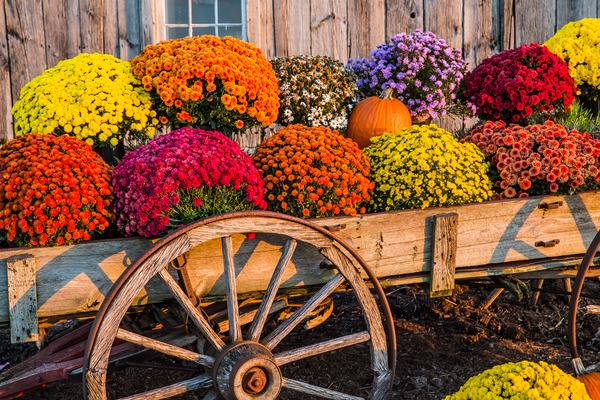Fall is Mum (short for Chrysanthemum) season, but if you’re thinking about putting some of these beauties in your yard or planters for some show stopping autumn color, you need to know the 411 on when and how to grow Fall’s Favorite Flower.
First, there are garden mums and florist mums, and the difference is their hardiness. Garden mums are tough perennials you plant outdoors where they can live year round. Florist mums are used as indoor potted plants and won’t survive a winter if you plunk them into your garden in the Midwest. Be sure you are buying the right mum for your purposes. Want a blooming plant to decorate the house for the Thanksgiving guests? Buy that foil wrapped pot of chrysanthemums in the floral section of the grocery store. Want a mum that will live for years in your yard? Get a mum suited for the great outdoors from a nursery or garden center.
Growing Mums
- Botanical Name: Chrysanthemum spp.
- Common Names: Garden mums, garden chrysanthemums, mums
- Hardiness Zones: 5 to 9 (Some varieties to Zone 4)
- Bloom Time: September to frost
- Growth Range: Chrysanthemums grow 1′ to 3′ tall and get 1′ to 2′ wide, depending on the type.
If you’re using a mum as a perennial, plant in early spring, or in the fall at least six weeks before the first killing frost. If you’re using chrysanthemums for a pop of fall color to boost your late season garden, plant them when they’re blooming in later summer or early fall and treat them as annuals. Mums grow best in full sun. Give them too little sunlight, and you’ll get a weak plant that produces few flowers. Mums are happiest in rich, well-drained soil. Add compost or other organic material to your soil when you plant to give your mum the best shot at being a strong, healthy plant.
Caring for Mums
Water chrysanthemums frequently, because they have a shallow root system that gets thirsty, fast. If the weather’s very hot and the rain scarce, they may need daily watering at the height of their summer growing season.
Mulch around mums to keep the soil moister, longer.
Prune chrysanthemums to make the plant branch and bloom more profusely. Clip off about one inch of the branch tops, two to three times per growing season. Stop pruning in late June or you won’t get flowers in the fall. Divide mums after new growth appears in the spring. Mums grown as perennials will spread so you’ll need to thin them periodically.
Taller varieties of mums may need to be staked when they’re full of blooms. Remove old foliage after the first frost. New growth comes from the roots.
Pests and Diseases
- Chrysanthemums can get leaf spot, powdery mildew and viruses like mosaic or stunt.
- The best treatment is prevention. Don’t crowd chrysanthemums or plant them in shade where moisture will remain on their leaves and create a breeding ground for disease. Give them plenty of air and sun.
- Mums are susceptible to the usual array of bugs: aphids, caterpillars, leafhoppers, leafminers and spider mites.
- Rabbits and deer usually don’t eat mums’ fuzzy, fragrant leaves and blooms. They much prefer your blueberry bushes.
Recommended Varieties
- ‘Clara Curtis’ is a tough, old-fashioned chrysanthemum flower, a passalong plant that has pink, daisy-like blooms with golden centers. Blooms are 2″ to 3″ in diameter.
- ‘Homecoming’ is the sort of big, gorgeous mum once a staple of fall corsages. It produces giant peach-colored blooms on 3-foot stalks.
- ‘Ruby Mound’ is a hardy garden mum with lush sprays of big, ruby-red semi-double flowers.
- ‘Fireglow Bronze’ produces branchfuls of golden double blooms on an 18-inch bush.
Garden Design Suggestions
- Mums are ideal for containers because of their shallow root systems.
- Use those pots of blooming mums sold in the fall as annuals to replace summer annuals that are past their prime. Tuck the mums in beds, borders or planters to keep the color coming until frost.
- Plant them in beds or borders in the early spring or fall as perennials. They come back each fall with more flowers.
- Plant chrysanthemums in swaths or clumps of the same color and flower type. Mass plantings are pleasing to the eye.
- Pair them with other late-season bloomers like sedum, goldenrod, Russian sage and asters.
- Use them in the middle of sunny borders, cutting gardens and butterfly gardens.
- Mums contain substances that can be toxic to cats, dogs and horses, so keep that in mind if you have pets that might munch on them.
—
Photo Credit: hutch photography / Shutterstock.com
